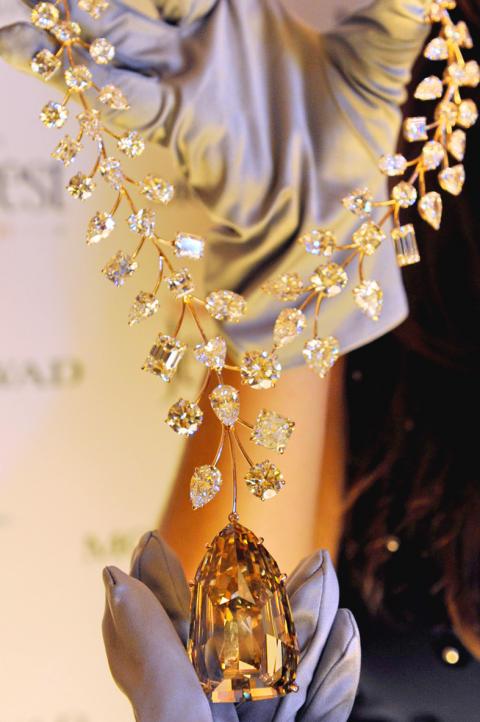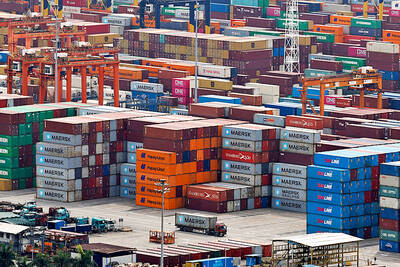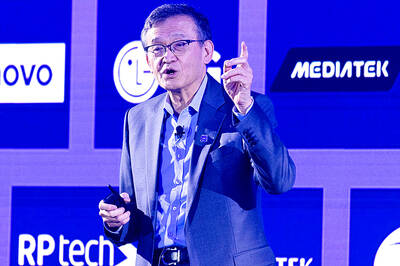For someone with US$55 million to spare on an egg-sized diamond, the world’s most expensive necklace is on sale this month at a jewelry show in Singapore, reflecting Asia’s growing appetite for precious gems and expensive baubles.
Known as L’Incomparable, the necklace created by luxury jeweler Mouawad features a yellow, internally flawless diamond of more than 407 carats suspended from a rose gold setting that is studded with 90 white diamonds weighing nearly 230 carats.
“Serious interest” has been expressed by a couple of potential buyers from Asia, said Jean Nasr, managing director of Mouawad in Singapore, declining to identify their nationalities.

Photo: AFP
“People who will get something like this are looking at it from a different perspective because this is definitely an investment piece,” he said.
The necklace, whose centerpiece diamond was found by chance in a pile of mining rubble by a young girl in the Democratic Republic of the Congo about 30 years ago, will be the flashiest item on offer at the Singapore JewelFest, which will run from Friday to Oct. 20.
However, there will be plenty of other glitz from US, European and Asian designers worth another US$200 million or so.
Singapore, a tiny Southeast Asian nation with the world’s highest concentration of millionaires, has positioned itself as a destination for the ultra-rich with a busy wealth management industry, luxury properties, top hotels, gourmet restaurants, high-end boutiques and two casinos.
While the city-state boasts a very low crime rate, security will be extremely tight with so much jewelry on display at a pavilion outside an upscale mall.
It seems unlikely there would be a robbery in Singapore like the daylight heist of about US$136 million worth of jewelry on show at a hotel in the French Riviera resort of Cannes in July.
However, Filippo Melchionni, in charge of guarding L’Incomparable and the rest of the jewelry on show, is taking no chances.
Security includes armed guards, plainclothes supervisors, cameras, motion detectors and bulletproof display cases, but the most critical time is when the pieces are shown to customers.
“This is the moment that the stones are under risk because they can be passed hand-by-hand, they can be exchanged,” said Melchionni, chief operating officer for Asia-Pacific at the Ferrari Group, an Italian logistics company for luxury goods.
“Every night it is going back to our vault. We have an armored truck to move the stones,” he said.
L’Incomparable, completed last year and certified as the priciest necklace in existence by Guinness World Records earlier this year, is an extravagant novelty.
However, Asia, especially China, has become an important and resilient growth area for sellers of pricey jewelry, cars, boats, wine, artwork and other lavish items.
Australian miner Rio Tinto Ltd , which showed off its finest colored diamonds in Hong Kong last month, believes the US will remain its key market for diamonds, but sees China growing fast.
Demand for diamonds in China, now the world’s second-largest market after the US, helped boost global sales at Tiffany & Co in the latest quarter, leading the US jeweler to raise its annual profit forecast.
The show in Singapore, now in its 11th year, expects some Chinese buyers, but many locals and visitors from Indonesia, Malaysia, Thailand, Vietnam, Cambodia and Russia will also be there, said Kean Ng, chairman of the Singapore JewelFest.
“You have the high-end customers, but of course you have the browsers coming in and they usually end up buying something that’s within their budget,” he said.

The Eurovision Song Contest has seen a surge in punter interest at the bookmakers, becoming a major betting event, experts said ahead of last night’s giant glamfest in Basel. “Eurovision has quietly become one of the biggest betting events of the year,” said Tomi Huttunen, senior manager of the Online Computer Finland (OCS) betting and casino platform. Betting sites have long been used to gauge which way voters might be leaning ahead of the world’s biggest televised live music event. However, bookmakers highlight a huge increase in engagement in recent years — and this year in particular. “We’ve already passed 2023’s total activity and

Nvidia Corp CEO Jensen Huang (黃仁勳) today announced that his company has selected "Beitou Shilin" in Taipei for its new Taiwan office, called Nvidia Constellation, putting an end to months of speculation. Industry sources have said that the tech giant has been eyeing the Beitou Shilin Science Park as the site of its new overseas headquarters, and speculated that the new headquarters would be built on two plots of land designated as "T17" and "T18," which span 3.89 hectares in the park. "I think it's time for us to reveal one of the largest products we've ever built," Huang said near the

China yesterday announced anti-dumping duties as high as 74.9 percent on imports of polyoxymethylene (POM) copolymers, a type of engineering plastic, from Taiwan, the US, the EU and Japan. The Chinese Ministry of Commerce’s findings conclude a probe launched in May last year, shortly after the US sharply increased tariffs on Chinese electric vehicles, computer chips and other imports. POM copolymers can partially replace metals such as copper and zinc, and have various applications, including in auto parts, electronics and medical equipment, the Chinese ministry has said. In January, it said initial investigations had determined that dumping was taking place, and implemented preliminary

Intel Corp yesterday reinforced its determination to strengthen its partnerships with Taiwan’s ecosystem partners including original-electronic-manufacturing (OEM) companies such as Hon Hai Precision Industry Co (鴻海精密) and chipmaker United Microelectronics Corp (UMC, 聯電). “Tonight marks a new beginning. We renew our new partnership with Taiwan ecosystem,” Intel new chief executive officer Tan Lip-bu (陳立武) said at a dinner with representatives from the company’s local partners, celebrating the 40th anniversary of the US chip giant’s presence in Taiwan. Tan took the reins at Intel six weeks ago aiming to reform the chipmaker and revive its past glory. This is the first time Tan